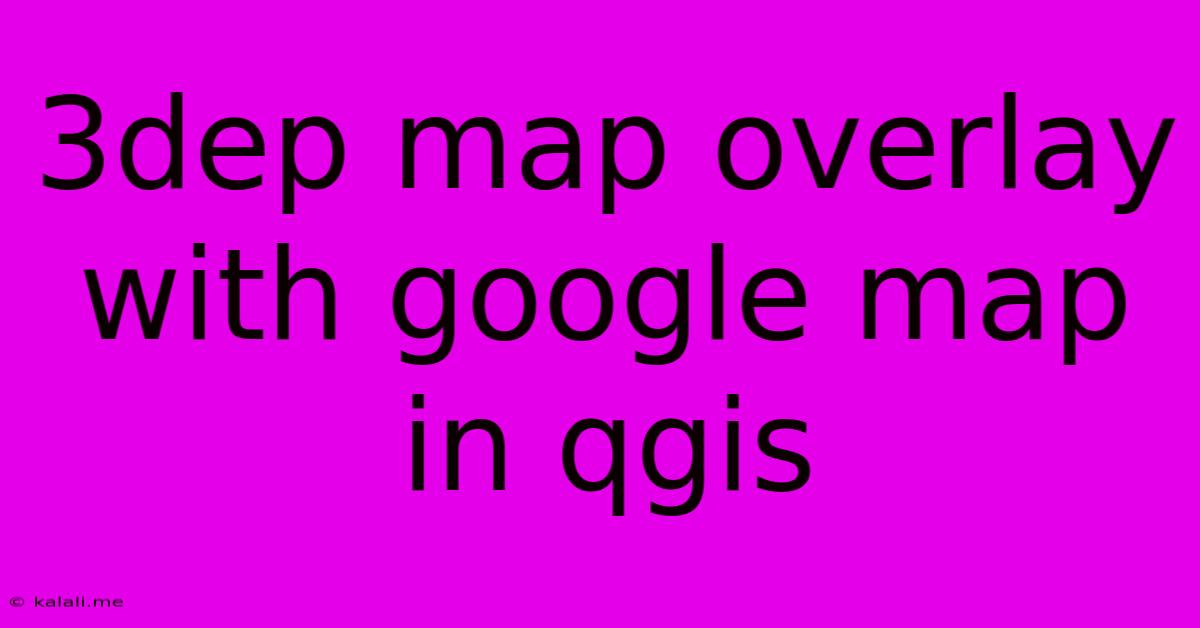3dep Map Overlay With Google Map In Qgis
Kalali
Jun 06, 2025 · 3 min read

Table of Contents
3D Map Overlay with Google Maps in QGIS: A Comprehensive Guide
Creating a compelling 3D map overlay with Google Maps in QGIS offers a powerful way to visualize geographic data and enhance spatial understanding. This guide will walk you through the process, covering everything from data preparation to final rendering. This technique is particularly useful for urban planning, environmental analysis, and presenting geographical information in an engaging and informative manner.
What you'll need:
- QGIS: A free and open-source Geographic Information System (GIS) software.
- Google Maps API Key: You'll need this to access Google Maps imagery within QGIS. The process for obtaining a key is readily available online through the Google Cloud Platform.
- Elevation Data: For a true 3D effect, you’ll need a Digital Elevation Model (DEM) dataset. Various sources provide free DEM data, such as the USGS and others. The resolution of your DEM will influence the detail in your 3D representation.
- Your GIS Data: This could be any vector or raster data you wish to overlay on the Google Maps basemap.
Step-by-Step Guide:
1. Adding the Google Maps Basemap:
- Obtain your API Key: Follow Google's instructions to create a project and generate an API Key with the necessary permissions for Maps JavaScript API.
- Install the QGIS plugin: Search for and install the "QuickMapServices" plugin within the QGIS plugin manager. This plugin facilitates the addition of various online map services, including Google Maps.
- Configure the plugin: Once installed, open the QuickMapServices plugin. You'll need to add your Google Maps API key to the plugin's settings. The exact location of this setting may vary depending on the plugin version, so refer to the plugin's documentation if necessary.
- Add the Google Maps layer: After entering your API Key, you can select Google Maps from the available basemaps and add it to your QGIS project.
2. Adding Your Data Layers:
Import your GIS data layers (shapefiles, GeoTIFFs, etc.) into QGIS. This might include points, lines, or polygons representing various features like buildings, roads, or land use. Ensure your data is properly projected to a suitable coordinate system, preferably one compatible with your Google Maps basemap (likely a projected coordinate system).
3. Integrating Elevation Data:
- Import the DEM: Import your Digital Elevation Model (DEM) into QGIS. This will add a layer representing the terrain elevation.
- Adjust the DEM’s appearance: You might need to adjust the color scheme and styling of the DEM to enhance visibility against the Google Maps imagery.
4. Creating the 3D View:
- Enable the 3D Map View: Navigate to the "View" menu and select "Open 3D Map View." This opens a separate 3D window displaying your layers.
- Adjust Camera Position: Use the controls in the 3D Map View to pan, zoom, and rotate the camera to get the desired perspective. Experiment with different angles and viewpoints to highlight the features of your data.
- Layer Styling: Adjust the symbology of your data layers in the 3D view to improve their visibility and clarity. Consider using different colors, transparency levels, and 3D extrusion for different layers.
5. Fine-tuning and Exporting:
- Layer Order: Adjust the order of your layers in the Layers Panel to ensure proper visibility and layering. Google Maps should typically be the bottom layer.
- Transparency: Adjust the transparency of layers to balance visibility between the Google Maps basemap and your overlay data.
- Exporting your 3D Map: QGIS allows for exporting the 3D view as an image (PNG, JPG) or a video. You can use these exports to share your visualization.
Tips for Optimization:
- Data simplification: If your data is very complex, consider simplifying it to improve performance.
- Caching: QGIS offers caching options to improve rendering speed, especially with large datasets.
- Resolution: Use appropriate resolution for both your DEM and your overlay data for optimal performance and visual quality.
By following these steps, you can effectively create a compelling 3D map overlay using Google Maps within QGIS. Remember to adjust settings based on your specific data and desired outcome. The ability to integrate various data sources with Google Maps imagery in a 3D environment provides a valuable tool for spatial analysis and presentation.
Latest Posts
Latest Posts
-
Can You Play Munchkin With 2 Players
Jun 06, 2025
-
Is It Better Being A Bodybuilder Then A Musician
Jun 06, 2025
-
How To Remove Someone From A Car Title
Jun 06, 2025
-
What Size Pipe For Washer Drain
Jun 06, 2025
-
Realm Bilbo Enter When Putting On The Ring
Jun 06, 2025
Related Post
Thank you for visiting our website which covers about 3dep Map Overlay With Google Map In Qgis . We hope the information provided has been useful to you. Feel free to contact us if you have any questions or need further assistance. See you next time and don't miss to bookmark.